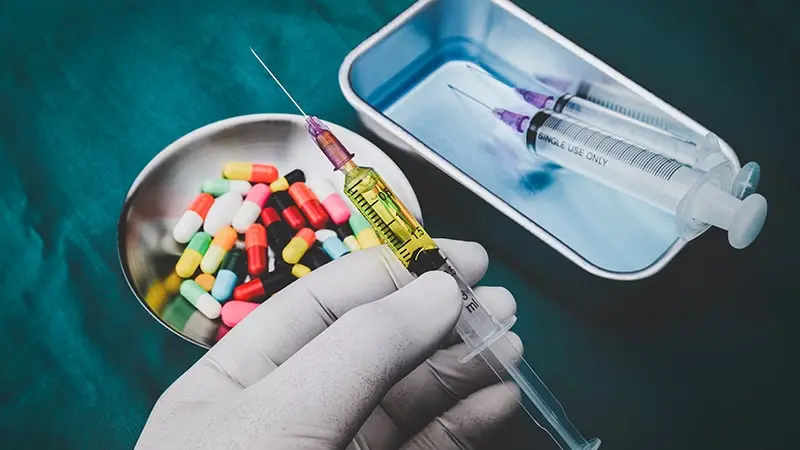Anabolic steroids, synthetic versions of the male sex hormone testosterone, are often used for muscle building and performance enhancement. However, managing cholesterol levels during a steroid cycle is a critical health consideration. Steroids can disrupt the lipid profile, potentially increasing the risk of cardiovascular disease. It’s essential for users to understand how steroids interact with cholesterol and to take proactive measures to mitigate these effects.
Diet and lifestyle play substantial roles in maintaining healthy cholesterol levels. When on a steroid cycle, individuals must be mindful of their dietary choices, prioritizing foods that support heart health. Regular exercise is also crucial, as it can help balance cholesterol levels. In addition to lifestyle changes, medical management involving medication may be necessary to control lipid levels during steroid use. Periodic monitoring through blood testing is key to ensure cholesterol levels are within safe ranges and to adjust management strategies accordingly.
Quick Summary
- Steroid cycles can influence cholesterol levels, increasing cardiovascular risk.
- A heart-healthy diet and regular exercise are vital to managing cholesterol during steroid use.
- Medical intervention and regular monitoring are essential to maintain cholesterol levels on steroid cycles.
Understanding Cholesterol and Steroid Use

Cholesterol management is crucial for individuals on anabolic steroid cycles as it can significantly impact their lipid profile.
Role of Cholesterol in the Body
Cholesterol, a waxy substance found in the bloodstream, is essential for the formation of cell membranes, certain hormones, and vitamin D synthesis. In the body, cholesterol is carried by lipoproteins, of which the two main types are low-density lipoprotein (LDL) and high-density lipoprotein (HDL). LDL is often referred to as “bad” cholesterol because high levels can lead to the buildup of plaque in arteries, a condition known as atherosclerosis. Conversely, HDL is known as “good” cholesterol, as it helps remove LDL from the arteries.
Impact of Anabolic Steroids on Lipid Profile
Anabolic steroids, synthetic versions of the steroid hormone testosterone, can disrupt the balance of lipids in the body. Their use has been associated with increased levels of LDL and decreased levels of HDL, raising the risk of atherosclerosis. Steroids can also affect lipoprotein particles such as apolipoproteins, which are crucial for lipid transport and metabolism. Regular monitoring of lipid profiles, including levels of LDL, HDL, and other lipoprotein particles, is essential for individuals using these substances.
References
- National Institute on Drug Abuse (NIDA). (2018). Anabolic Steroids. Retrieved from https://www.drugabuse.gov/publications/drugfacts/anabolic-steroids
- American Heart Association (AHA). (2020). What Your Cholesterol Levels Mean. Retrieved from https://www.heart.org/en/health-topics/cholesterol/about-cholesterol/what-your-cholesterol-levels-mean
Effects of Steroid Cycles on Cardiovascular Health

Steroid use can notably impact cardiovascular health, particularly by altering lipoprotein levels, which may increase the risk of cardiovascular diseases (CVD).
How Steroids Influence HDL and LDL Levels
Anabolic-androgenic steroids have been shown to reduce levels of high-density lipoprotein (HDL) cholesterol, often referred to as the “good” cholesterol. HDL plays a key role in transporting cholesterol to the liver for removal from the body. Conversely, steroids can increase levels of low-density lipoprotein (LDL) cholesterol, known as “bad” cholesterol, which is linked to a higher incidence of atherosclerosis. These changes can contribute to the thickening and narrowing of the arterial walls.
HDL Cholesterol Influence: Decrease
LDL Cholesterol Influence: Increase
Steroids and Cardiovascular Risk Factors
The use of steroids can exacerbate other cardiovascular risk factors beyond lipoprotein levels. For instance, steroid cycles might lead to an increase in total cholesterol, a recognized factor for heart disease. Additionally, steroid use is associated with higher blood pressure (hypertension), which is a critical risk factor for both heart disease and stroke. Moreover, steroid-induced alterations in lipid profiles and blood pressure can contribute synergistically to overall cardiovascular risk.
Cardiovascular Risk Factor Exacerbation:
- Total Cholesterol: Increased
- Hypertension: More likely
- Heart Disease Risk: Elevated
- Stroke Risk: Elevated
References
- “Effects of anabolic steroids on the muscle cells of strength-trained athletes.” Medicine and Science in Sports and Exercise. Available from: https://pubmed.ncbi.nlm.nih.gov/10589853/
- “Anabolic-Androgenic Steroid Therapy in the Treatment of Chronic Diseases.” The Journal of Clinical Endocrinology & Metabolism. Available from: https://academic.oup.com/jcem/article/86/11/5108/2848475
Diet, Exercise, and Lifestyle Adjustments

Making targeted changes in diet, exercise, and lifestyle can positively affect one’s cholesterol levels and overall heart health during a steroid cycle. These modifications are crucial to manage potential lipid profile alterations.
Constructing a Cholesterol-Friendly Diet
A cholesterol-friendly diet should include a variety of nutrient-rich foods that can help lower LDL cholesterol and boost HDL cholesterol. Fiber is essential; individuals should consume ample soluble fiber from sources like oats, legumes, and fruits. It’s important to limit intake of saturated fats found in red meat and dairy products while incorporating healthy fats from fish, nuts, and seeds which are rich in omega-3 fatty acids. Including plant sterols and stanols found in specially-formatted foods can also aid in reducing cholesterol absorption.
- Daily Nutrition Goals:
- Soluble Fiber: Aim for at least 5-10g
- Omega-3 Fats: Include 2-3 servings of fatty fish per week
- Plant Sterols/Stanols: Consume 2g per day
Exercise Regimens to Improve Lipid Profiles
Regular physical activity is important for maintaining a healthy lipid profile. A mix of aerobic exercises such as brisk walking, swimming, or cycling, for at least 30 minutes a day can increase HDL-C (the “good” cholesterol) and lower triglycerides. Resistance training can also be beneficial when performed at least twice a week. It’s critical for individuals to find an exercise routine that is sustainable and enjoyable to ensure consistency.
- Weekly Exercise Objectives:
- Aerobic Activity: Minimum 150 minutes of moderate-intensity
- Resistance Training: At least two days of muscle-strengthening activities
Lifestyle Changes to Mitigate Risks
Lifestyle changes can provide additional support in managing cholesterol levels. Maintaining a healthy weight is key; obesity is a significant risk factor for high cholesterol. Avoiding smoking is essential as it can lower HDL-C and harm the cardiovascular system. Managing stress through mindfulness, yoga, or other relaxation techniques can have a positive impact on overall health and lipid levels.
- Lifestyle Targets:
- Weight Management: Strive for a BMI within the normal range
- Smoking Cessation: Seek resources to quit smoking entirely
- Stress Reduction: Incorporate stress-managing practices regularly
Medical Management of Cholesterol on Steroid Cycles

When on a steroid cycle, managing serum cholesterol levels is critical due to the potential for steroids to disrupt the lipid profile. A well-planned medical protocol often includes the use of specific cholesterol-lowering drugs, with special attention to how these medications interact with the body’s chemistry during steroid use.
Utilizing Cholesterol-Lowering Drugs
Healthcare professionals may prescribe cholesterol-lowering drugs to mitigate the risk of elevated serum cholesterol, particularly low-density lipoprotein (LDL), and triglycerides which are commonly affected by anabolic steroids. These drugs include:
- Statins (HMG-CoA reductase inhibitors): Often the first line of treatment, statins work by blocking a substance your body needs to make cholesterol, which in turn helps lower LDL cholesterol and triglycerides.
- Ezetimibe: It can reduce the amount of cholesterol absorbed by the body from food, lowering LDL cholesterol.
- Bile Acid Sequestrants: These medications bind to bile acids, prompting the liver to use excess cholesterol to create more bile acids, which may help lower LDL cholesterol levels.
Understanding the Role of Statins and Other Medications
Statins not only lower serum cholesterol levels but may also have anti-inflammatory properties which are beneficial for patients on steroid cycles. However, the risk of drug interactions between statins and steroids must be monitored. Other medications, such as ezetimibe, can be used in combination with statins for a synergistic effect on lowering cholesterol. It is imperative for patients to have their lipid profiles regularly monitored to ensure medications are having the intended effect and to adjust dosages accordingly.
References
Monitoring and Testing Strategies

Effective management of cholesterol levels during a steroid cycle requires diligent monitoring and testing. This approach ensures timely identification and management of any undesirable alterations in lipid metabolism.
Regular Lipid Panel Testing
Healthcare providers generally recommend that individuals on a steroid cycle undergo regular lipid panel testing. This test should be conducted at baseline before starting the steroid regimen and periodically throughout the cycle. The lipid panel typically includes measurements of serum lipids: total cholesterol, high-density lipoprotein (HDL) cholesterol, low-density lipoprotein (LDL) cholesterol, and triglycerides. The frequency of testing can vary based on the individual’s risk factors and the type of steroids used. Regular testing helps in keeping track of how the steroids may be affecting the body’s cholesterol transport and lipid metabolism processes.
Interpreting Cholesterol Test Results
Understanding the results of a lipid panel is crucial for managing cholesterol levels on a steroid cycle. An increase in LDL cholesterol and a decrease in HDL cholesterol may indicate an elevated risk of cardiovascular disease. The LDL receptor plays a significant role in the regulation of serum cholesterol levels by facilitating the removal of LDL from the bloodstream. In cases of anabolic steroid use, LDL levels might rise, leading to a change in the usual cholesterol transport mechanism and an increased cardiovascular risk. It’s important for individuals to work with their healthcare providers to understand their specific test results within the context of their overall health.
- Total Cholesterol: <140-200 mg/dL (Desirable)
- LDL Cholesterol: <100 mg/dL (Optimal)
- HDL Cholesterol: >60 mg/dL (Protective against heart disease)
- Triglycerides: <150 mg/dL (Normal)
Interpretation should take into account personal health factors such as age, gender, and family history. When analyzing lipid panel results, changes should be contextualized within the individual’s baseline measurements and therapeutic targets established by their healthcare provider.
Frequently Asked Questions

Understanding the relationship between anabolic steroids and cholesterol is crucial for those aiming to maintain cardiovascular health during and after a steroid cycle.
What are the impacts of anabolic steroids on cholesterol levels?
Anabolic steroids often increase LDL (bad) cholesterol and decrease HDL (good) cholesterol levels, potentially leading to an increased risk of cardiovascular diseases.
How can bodybuilders manage cholesterol levels during a steroid cycle?
Bodybuilders can manage their cholesterol levels by incorporating a cholesterol-friendly diet, engaging in regular cardiovascular exercise, and possibly using supplements known to support lipid profiles.
What measures can be taken to minimize the adverse effects of steroids on cholesterol?
To minimize the adverse effects, one should follow a heart-healthy lifestyle, monitor blood lipid levels regularly, and consider using steroids with a less adverse effect on the lipid profile.
Are certain steroids known to have less impact on cholesterol levels?
Yes, some steroids are believed to have a milder impact on cholesterol levels. For example, injectable steroids may have a lower effect on cholesterol compared to oral steroids.
How long typically does it take for cholesterol levels to normalize after discontinuing steroid use?
Cholesterol levels may start to improve within weeks after discontinuing steroid use, but it can take several months for levels to completely return to baseline.
What lifestyle changes are recommended for controlling cholesterol when on Testosterone Replacement Therapy (TRT)?
Individuals on TRT are advised to adopt a diet low in saturated fats and cholesterol, maintain a regular exercise regimen, and avoid tobacco and excessive alcohol consumption.
References
https://www.ahajournals.org/doi/10.1161/CIRCULATIONAHA.106.180674
https://www.ncbi.nlm.nih.gov/pmc/articles/PMC3827559/
Dr. Grant Fourie, a specialist in male hormones, is based in Cape Town, South Africa. He provides comprehensive treatments for conditions related to low testosterone, such as erectile dysfunction, fatigue, and mood changes. His methods include hormone replacement therapy and other modern treatment options.
Contact me via email or phone to book personal appointment in my clinic: The Village Square, Cape Town - South Africa



